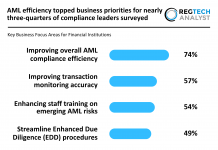Trade finance is the engine behind approximately 80% of global trade, supporting more than $25tn in annual transactions. Its role is vital in reducing payment and counterparty risk across international commerce.
However, this scale also makes it a lucrative target for fraud. According to the International Chamber of Commerce, fraudulent activity could account for over $50bn annually—roughly 1% of all trade finance transactions, claimed Resistant AI, in a recent thorough guide to trade finance fraud by the company.
Trade finance fraud typically involves falsified documents and forged identities used to simulate legitimate trade activity. Fraudsters manipulate documents like letters of credit, invoices, and bills of lading to secure financing for goods that may not exist. The most effective defence is a layered approach that includes AI-powered document verification tools, such as those offered by Resistant AI.
This type of fraud exploits the industry’s heavy reliance on documents. Financial institutions depend on a wide range of paperwork to assess and approve funding—everything from invoices and shipping documents to certificates of origin. These documents are vulnerable to forgery, particularly with the advent of generative AI and template-based falsification. Fraud schemes often focus on cross-border trade, where verifying authenticity becomes even harder, and losses can quickly escalate. A notable example is the Balli Steel case, where more than $500m was defrauded using fake shipping paperwork.
The nature of trade finance, with multiple actors and documentation-intensive workflows, makes fraud difficult to detect. Criminals may inflate invoice values, submit duplicate transactions, or falsify cargo records. Letters of credit are frequently abused, with forged documents presented to banks to extract payments before the underlying fraud is uncovered. By that point, the funds are often dispersed across offshore accounts, making recovery virtually impossible.
A typical fraud scenario unfolds in several steps. It begins with an application for trade financing using forged documents. The documents pass initial checks, appearing legitimate. Once the loan is approved, the money is moved through shell companies or withdrawn as cash. The fraud is usually only discovered once the expected shipment fails to materialise—by then, it’s often too late.
Fraudsters range from rogue traders to organised criminal networks, often working in collusion with insiders at banks or logistics companies. Their victims include financial institutions, insurers, and legitimate businesses—many of which suffer significant monetary and reputational damage. Legal remedies are time-consuming and rarely lead to full recovery due to the cross-border nature of the crime.
Trade finance is particularly vulnerable due to its dependence on manual, paper-based verification processes. Many institutions still rely on outdated compliance systems and fragmented due diligence methods. These gaps provide fertile ground for fraud. Once funds are transferred, they are swiftly laundered or hidden, making recovery nearly impossible.
The consequences are far-reaching. Trade finance fraud has pushed banks out of the market, destabilised supply chains, and shaken investor confidence. A high-profile example is the Hin Leong scandal in Singapore, which triggered losses of up to $600m per bank and led to major institutions like ABN Amro, BNP Paribas, and Société Générale exiting commodity trade finance altogether.
Beyond financial losses, fraud can disrupt diplomatic relations and global trade flows. Disputes over fraudulent shipments may lead to cargo seizures or legal conflict, triggering regulatory backlash and loss of trust among trading partners. This may also result in “de-risking”—where banks avoid certain regions to limit compliance exposure—ultimately harming financial inclusion.
There is also a direct economic impact. Rising fraud rates increase the cost of trade credit insurance and due diligence, costs which are passed on to businesses. As a result, global trade becomes more expensive and harder to execute, particularly in emerging markets where access to capital is already constrained.
Trade finance fraud also contributes to a growing global funding gap, which hit $2.5tn in 2022. As banks pull back, legitimate traders—especially SMEs and those in developing economies—face growing difficulty in accessing essential financing. This retreat undermines long-term economic growth and weakens the resilience of global supply chains.
Read the full blog here.
Read the daily RegTech news
Copyright © 2025 RegTech Analyst
Copyright © 2018 RegTech Analyst






